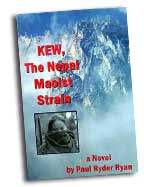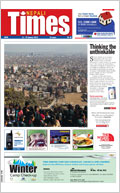 Mary Carew, nom de guerre 'Kew' after the famous gardens in London, is an American guerrilla fighter with a leadership role in the Maoists of Nepal. She is also blinded in one eye, a Buddhist spiritualist, conversant in Nepali, the mistress of Comrade Prachanda and living in 'the forbidden Kingdom of Lo', or was it Dolpo. Her father and brother, ex-army and trekking types, are commissioned by the US secret services to track her down before she gets more deeply embedded with the insurgents than she already is. At the behest of Prachanda, she meets with Chen Hui, a Chinese Professor of Microbiology and Chemistry who has perfected the airborne dispersal of germ anthrax and is eager to unleash a few canisters over the United States. Aim: to sow death, misery and probably the seeds of WW III. Enough already? No, the final battle takes place in Mustang and involves a CIA operative, the American Himalayan Foundation, Tibetan Khampas and a clutch of automatic weapons. Thankfully, the bad guys are all destroyed, a requisite number of good guys die with them (to make it realistic) and the world is saved by the ingenuity and resilience of a band of Americans. Oh dear.
Mary Carew, nom de guerre 'Kew' after the famous gardens in London, is an American guerrilla fighter with a leadership role in the Maoists of Nepal. She is also blinded in one eye, a Buddhist spiritualist, conversant in Nepali, the mistress of Comrade Prachanda and living in 'the forbidden Kingdom of Lo', or was it Dolpo. Her father and brother, ex-army and trekking types, are commissioned by the US secret services to track her down before she gets more deeply embedded with the insurgents than she already is. At the behest of Prachanda, she meets with Chen Hui, a Chinese Professor of Microbiology and Chemistry who has perfected the airborne dispersal of germ anthrax and is eager to unleash a few canisters over the United States. Aim: to sow death, misery and probably the seeds of WW III. Enough already? No, the final battle takes place in Mustang and involves a CIA operative, the American Himalayan Foundation, Tibetan Khampas and a clutch of automatic weapons. Thankfully, the bad guys are all destroyed, a requisite number of good guys die with them (to make it realistic) and the world is saved by the ingenuity and resilience of a band of Americans. Oh dear. Anyone with a predilection towards paranoia, conspiracy theories or weapons of mass destruction should definitely neither purchase nor read this book. There are enough half-baked, specious and entirely maniacal speculations to keep the present US administration in foreign policy for a good five years. All the more reason, then, that this treatise should not enter the public discourse. Better to denounce it now, outright, than to let someone pick it up by mistake and believe even a single word of it. I also don't believe that the writer can claim any protection by branding his book as 'a novel'. Disseminating deranged ideas in the volatile political climate of the present is simply irresponsible.
Aside from the fantastical plot, the book is peppered with mistakes and misrepresentations: 'Nemaste', says Gail Tenzing Carew (the daughter of 'Norgay Tenzing', of course). One would have thought that Paul Ryder Ryan might have been able to check the spelling of this now almost international greeting. Proper names are so frequently misspelled that we may have to put them down to Ryan's failed attempt at preserving a pretence of the unreal (or protecting his sources): a town outside Kathmandu called 'Braktapur', a lake in Dolpo called 'Proksumdo', three-day general strikes called 'bundhs' and a US Ambassador to Nepal named 'Ralph Drank'. In a discussion on why the 'peasants' of Nepal have been effectively galvanised by Maoist ideology, we learn that 'Mao is just another god in Nepal' (page 8).
From the back cover, it appears that the author has spent 'more than ten years travelling and working in Asia, most recently in troubled South Asia', although what troubled him about the region remains unsaid. According to a disclaimer preceding Chapter One, 'while all the characters are fictional, the fabric of the bloody historical events depicted in this book.are a tapestry woven from known facts, the author's imagination, and public statements'. The known facts, I should add, are almost twenty pages of the 1999 interview between Revolutionary Worker and Prachanda, reproduced in their entirety as Chapter 3 of the novel, and five pages of the special report on the 1 June massacre of 2001. The rest can indeed be put down to the author's considerable imagination.
KEW, The Nepal Maoist Strain is published by 1st Books Library, an outfit which specialises in 'publishing on demand'. This should have warned me away in the first place, since no reputable book house would go near such inflammatory and jingoistic drivel, but fascination with the title overwhelmed me and I purchased a copy anyway. Save yourself the trouble.
(Mark Turin is is currently with the Department of Social Anthropology at University of Cambridge.)
See also: 'The peoples' peace' by Puskar Bhusal, Nepali Times, #123.


